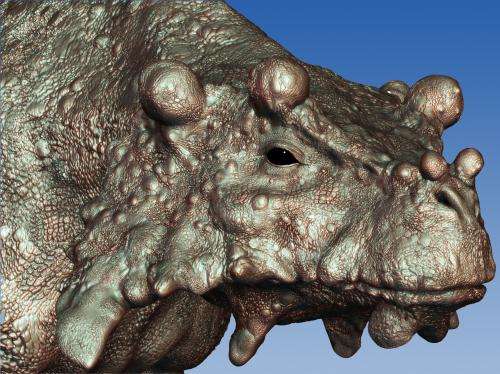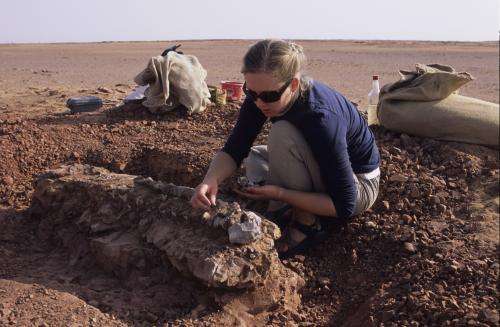Bumpy beast was a desert dweller

During the Permian era, the Earth was dominated by a single supercontinent called Pangea – "All-Earth". Animal and plant life dispersed broadly across this land, as documented by identical fossil species found on multiple modern continents. But a new study published in the Journal of Vertebrate Paleontology supports the idea that there was an isolated desert in the middle of Pangea with a fauna all its own.
Roaming this desert in what is now northern Niger was a very distinctive creature known as a pareiasaur. Pareiasaurs were large, herbivorous reptiles that were common across Pangea during the Middle and Late Permian, about 266-252 million years ago. "Imagine a cow-sized, plant-eating reptile with a knobby skull and bony armor down its back," said lead author Linda Tsuji. The newly discovered fossils belong to the aptly-named genus Bunostegos, which means "knobby [skull] roof."
Most pareiasaurs had bony knobs on their skulls, but Bunostegos sported the largest, most bulbous ones ever discovered. In life, these were probably skin-covered horns like those on the heads of modern giraffes. Although at first blush these features seem to suggest that Bunostegos was an evolutionarily advanced pareiasaur, it also had many primitive characteristics. Tsuji's analysis showed that Bunostegos was actually more closely related to older and more primitive pareiasaurs, leading to two conclusions: first, that its knobby noggin was the result of convergent evolution, and second, that its genealogical lineage had been isolated for millions of years.
So how do you isolate a population of cow-sized reptiles? Though there were no fences in the Permian, climatic conditions conspired to corral Bunostegos – along with several other reptiles, amphibians, and plants – and keep them constrained to the central area of the supercontinent. "Our work supports the theory that central Pangea was climatically isolated, allowing a unique relict fauna to persist into the Late Permian," said Christian Sidor, another author of the paper. This is surprising because areas outside this central region show fossil evidence of regular faunal interchange.

Geological data also show that central Pangea was hyperarid (extremely dry), effectively discouraging some animals from passing through, while keeping those within from venturing out. The long period of isolation under these parched conditions gave Bunostegos lineage time to evolve its unique anatomical features.
Paleontologist Gabe Bever, who was not involved with the study, said "Research in these lesser-known basins is critically important for meaningful interpretation of the Permian fossil record. Our understanding of the Permian and the mass extinction that ended it depends on discovery of more fossils like the beautifully bizarre Bunostegos."
Much of what was once central Pangea remains to be explored by paleontologists. "It is important to continue research in these under-explored areas," said Tsuji. "The study of fossils from places like northern Niger paints a more comprehensive picture of the ecosystem during the Permian era."
More information: Linda A. Tsuji, Christian A. Sidor, Sebastien Steyer, Roger M. H. Smith, Neil J. Tabor, and Oumarou Ide. 2013. The vertebrate fauna of the Upper Permian of Niger – VII. Cranial anatomy and relationships of Bunostegos akokaensis (Pareiasauria). Journal of Vertebrate Paleontology 33(4). www.tandfonline.com/toc/ujvp20/current
Journal information: Journal of Vertebrate Paleontology
Provided by Society of Vertebrate Paleontology

















